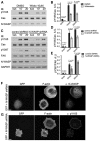N-WASP-directed actin polymerization activates Cas phosphorylation and lamellipodium spreading
- PMID: 24481817
- PMCID: PMC3970555
- DOI: 10.1242/jcs.134692
N-WASP-directed actin polymerization activates Cas phosphorylation and lamellipodium spreading
Abstract
Tyrosine phosphorylation of the substrate domain of Cas (CasSD) correlates with increased cell migration in healthy and diseased cells. Here, we address the mechanism leading to the phosphorylation of CasSD in the context of fibronectin-induced early spreading of fibroblasts. We have previously demonstrated that mechanical stretching of CasSD exposes phosphorylation sites for Src family kinases (SFKs). Surprisingly, phosphorylation of CasSD was independent of myosin contractile activity but dependent on actin polymerization. Furthermore, we found that CasSD phosphorylation in the early stages of cell spreading required: (1) integrin anchorage and integrin-mediated activation of SFKs, (2) association of Cas with focal adhesion kinase (FAK), and (3) N-WASP-driven actin-assembly activity. These findings, and analyses of the interactions of the Cas domains, indicate that the N-terminus of Cas associates with the FAK-N-WASP complex at the protrusive edge of the cell and that the C-terminus of Cas associates with the immobilized integrin-SFK cluster. Thus, extension of the leading edge mediated by actin polymerization could stretch Cas during early cell spreading, priming it for phosphorylation.
Keywords: Actin dynamics; BCAR1; Cas; Crk-associatied substrate; FAK; Focal adhesion kinase; SFK; Src family kinase; p130Cas.
Figures






Similar articles
-
Displacement of p130Cas from focal adhesions links actomyosin contraction to cell migration.J Cell Sci. 2014 Aug 15;127(Pt 16):3440-50. doi: 10.1242/jcs.143438. Epub 2014 Jun 13. J Cell Sci. 2014. PMID: 24928898
-
Focal adhesion kinase controls actin assembly via a FERM-mediated interaction with the Arp2/3 complex.Nat Cell Biol. 2007 Sep;9(9):1046-56. doi: 10.1038/ncb1626. Epub 2007 Aug 26. Nat Cell Biol. 2007. PMID: 17721515
-
Introduction of p130cas signaling complex formation upon integrin-mediated cell adhesion: a role for Src family kinases.Mol Cell Biol. 1996 Jun;16(6):2606-13. doi: 10.1128/MCB.16.6.2606. Mol Cell Biol. 1996. PMID: 8649368 Free PMC article.
-
New concepts regarding focal adhesion kinase promotion of cell migration and proliferation.J Cell Biochem. 2006 Sep 1;99(1):35-52. doi: 10.1002/jcb.20956. J Cell Biochem. 2006. PMID: 16823799 Review.
-
Src kinases as therapeutic targets for cancer.Nat Rev Clin Oncol. 2009 Oct;6(10):587-95. doi: 10.1038/nrclinonc.2009.129. Nat Rev Clin Oncol. 2009. PMID: 19787002 Review.
Cited by
-
Synergistic phase separation of two pathways promotes integrin clustering and nascent adhesion formation.Elife. 2022 Jan 20;11:e72588. doi: 10.7554/eLife.72588. Elife. 2022. PMID: 35049497 Free PMC article.
-
Invadosomes are coming: new insights into function and disease relevance.FEBS J. 2018 Jan;285(1):8-27. doi: 10.1111/febs.14123. Epub 2017 Jun 22. FEBS J. 2018. PMID: 28548369 Free PMC article. Review.
-
Integrin Mechano-chemical Signaling Generates Plasma Membrane Nanodomains that Promote Cell Spreading.Cell. 2019 Jun 13;177(7):1738-1756.e23. doi: 10.1016/j.cell.2019.04.037. Epub 2019 May 16. Cell. 2019. PMID: 31104842 Free PMC article.
-
Cas phosphorylation regulates focal adhesion assembly.Elife. 2023 Jul 25;12:e90234. doi: 10.7554/eLife.90234. Elife. 2023. PMID: 37489578 Free PMC article.
-
CAS proteins in health and disease: an update.IUBMB Life. 2014 Jun;66(6):387-95. doi: 10.1002/iub.1282. Epub 2014 Jun 24. IUBMB Life. 2014. PMID: 24962474 Free PMC article. Review.
References
Publication types
MeSH terms
Substances
Grants and funding
LinkOut - more resources
Full Text Sources
Other Literature Sources
Research Materials
Miscellaneous

